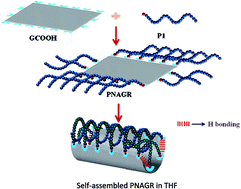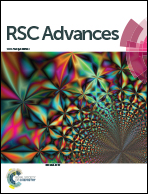Unique nanotubes from polynorbornene derived graphene sheets†
Abstract
Graphene functionalized polynorbornene nanohybrids (PNAGRs) have been synthesized successfully and their interesting self-aggregation in organic solvent, tetrahydrofuran (THF) has been investigated thoroughly for the 1st time in our present study. The unique hybrids have been fabricated by amide linkages between the activated carboxylic acid group of graphene carboxylic acid (GCOOH) and the pending amine group of synthesized homopolynorbornene (P1). Homopolynorbornene is synthesized by Ring Opening Metathesis Polymerization Technique (ROMP) and is characterized by custom analytical techniques. Formation of hybrid materials with varying GCOOH content is confirmed by Infrared spectroscopy, Raman spectroscopy and Powdered X-ray Diffractometry. The uniform nano-aggregates of the fabricated nanohybrids, PNAGRs in THF has been observed by a Differential Light Scattering study. These nano-aggregates appear as fine nanotubes under Field Emission Scanning Electron Microscope and High Resolution Transmission Electron Microscope. Further, iron encapsulation of PNAGRs is performed to produce PNFs and is confirmed by FESEM, Energy Dispersive X-ray Spectroscopy and Elemental analyses. We envision that this unique observation of the self-assembly of graphene functionalized norbornene polymer into the formed carbon nanotubes will open up new avenues in materials chemistry applications, such as contrast agents for MRI.


 Please wait while we load your content...
Please wait while we load your content...